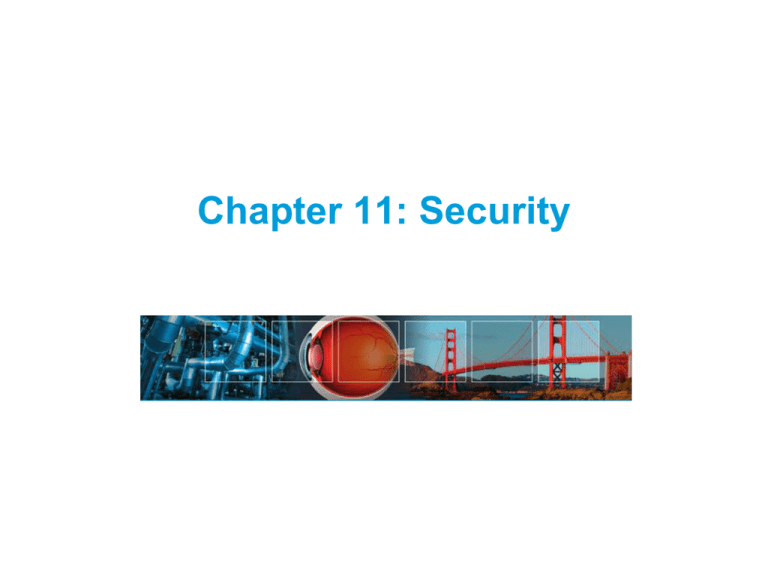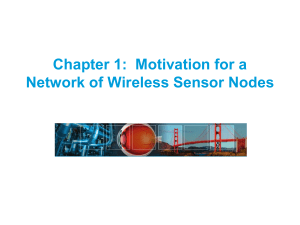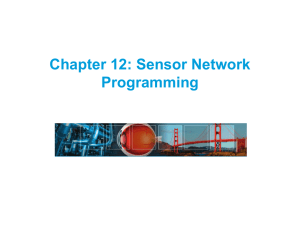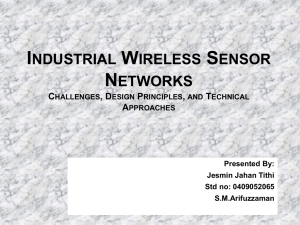PPT - extended version
advertisement

Chapter 11: Security
Chapter 11: Roadmap
Security fundamentals
Security challenges
Security attacks
Security protocols and mechanisms
IEEE 802.15.4 and ZigBee security
Fundamentals of Wireless Sensor Networks: Theory and Practice
Waltenegus Dargie and Christian Poellabauer © 2010
2
Fundamentals
Security and privacy are big challenges for any type of computing and
networking environment
Well-known CIA security model:
Confidentiality
ensure that only the intended receiver can read/interpret a message
unauthorized access is prevented
Integrity
ensure that a message cannot be modified
unauthorized individuals should not be able to destroy/alter message
Availability
ensure that system/network is able to perform its tasks without
interruption
often measured in terms of percentages of up/down time
Fundamentals of Wireless Sensor Networks: Theory and Practice
Waltenegus Dargie and Christian Poellabauer © 2010
3
Examples
Confidentiality:
eavesdropping: unauthorized message reception
Integrity:
man-in-the-middle attack: unauthorized individual/system positions itself
between sender and receiver to intercept, modify, and retransmit
messages
Availability:
denial-of-service attack: attempt to disrupt transmission or service
Fundamentals of Wireless Sensor Networks: Theory and Practice
Waltenegus Dargie and Christian Poellabauer © 2010
4
More Terminology
Authentication
process of establishing or confirming the identity of user/device
ensures that message came from who it claims to have come from
Nonrepudiation
process of proving that person/device has performed a certain
transaction/transmission
Digital signatures
often used to support authentication, nonrepudiation, and integrity
Fundamentals of Wireless Sensor Networks: Theory and Practice
Waltenegus Dargie and Christian Poellabauer © 2010
5
Cryptography
Process of protecting information using encoding/decoding techniques
Symmetric key cryptography
single key shared between communicating parties
simple example: shift cipher (key = fixed shift in alphabet)
challenge: secure distribution of shared key
examples: DES, AES, IDEA
Public key cryptography
secret key: will never be shared with anyone else
public key: can be shared freely
message encrypted with secret key can only be decrypted with
corresponding public key (e.g., for authenticating the sender)
message encrypted with public key can only be decrypted with
corresponding secret key (e.g., for providing confidentiality)
examples: RSA, Diffie-Hellman agreement protocol
Fundamentals of Wireless Sensor Networks: Theory and Practice
Waltenegus Dargie and Christian Poellabauer © 2010
6
Challenges of Security in WSNs
Resource constraints
limited computational, networking, and storage capabilities of sensors
energy constraints of sensors
Lack of central control
large WSNs often don’t have centralized control
requires distributed/decentralized security solutions
Remote location
sensors often left unattended
difficult to prevent unauthorized physical access and tampering
Error-prone communication
difficult to distinguish wireless communication errors from attacks
Fundamentals of Wireless Sensor Networks: Theory and Practice
Waltenegus Dargie and Christian Poellabauer © 2010
7
Security in WSNs
WSN characteristics that facilitate security:
self-managing and self-repairing nature
redundancy
Data freshness problem
WSN security must ensure that sensor data are recent (and not replays
of old data)
particularly important for key distribution schemes
WSNs provide more opportunities for attacks than other networks
many sensor protocols require location information
many sensor nodes require accurate time synchronization
both can be affected by modifying, injecting, dropping messages (e.g.,
beacons) carrying such information
Fundamentals of Wireless Sensor Networks: Theory and Practice
Waltenegus Dargie and Christian Poellabauer © 2010
8
Denial-of-Service (DoS)
Attempt to stop network/system from functioning or providing a service
Physical Layer DoS
jamming attack
interfere with the radio frequencies of a WSN
even small numbers of attacking nodes can be effective if well
positioned (e.g., close to an important node such as a BS) or if their
signals are strong
countermeasure: spread-spectrum communication (e.g., FHSS)
tampering attack
attacker obtains physical access to sensor node
used to modify/destroy node, obtain sensitive information or use as
entry points for further attacks into the network
countermeasures: tamper-proof materials and enclosures, disable
device when attack detected
Fundamentals of Wireless Sensor Networks: Theory and Practice
Waltenegus Dargie and Christian Poellabauer © 2010
9
Denial-of-Service (DoS)
Link Layer DoS
collision attack
attempt to interfere with packet transmissions
causes costly exponential backoff procedures and retransmissions
often tries to cause collisions near the end of a frame, requiring
retransmission of entire frame
exhaustion attack
attacks (such as collision attack) with the goal of premature
depletion of a sensor’s energy sources
example: issue RTS message to prompt CTS response from another
node (exploiting handshake techniques)
Fundamentals of Wireless Sensor Networks: Theory and Practice
Waltenegus Dargie and Christian Poellabauer © 2010
10
Attacks on Routing
Blackhole attack
Selective forwarding attack
similar to blackhole attack, but not all traffic is dropped
more difficult to detect (hard to distinguish attack from poor connectivity)
Rushing attack
exploits route discovery techniques of on-demand protocols
route request packets are rushed towards destination, increasing the malicious
node’s probability to be on the selected route
Sinkhole attack
node attempts to position itself on as many network flows as possible
Sybil attack
malicious node on a route simply drops all packets
attacker claims to have multiple identities or locations
Wormhole attack
out-of-band (bandwidth-rich) connection between attackers used to face short
path to the gateway, attracting many flows to these nodes
Fundamentals of Wireless Sensor Networks: Theory and Practice
Waltenegus Dargie and Christian Poellabauer © 2010
11
Attacks on Transport Layer
Flooding attack
exploits fact that many transport protocols maintain state information
and are therefore vulnerable to memory exhaustion
example: attacker makes many (incomplete) connection requests,
forcing a node to allocate more and more resources
Desynchronization attack
attempt to disrupt communication between nodes by repeatedly forging
messages to these nodes
example: fake packets carry old sequence numbers to make a node
believe that its previous transmissions were not correctly received
Fundamentals of Wireless Sensor Networks: Theory and Practice
Waltenegus Dargie and Christian Poellabauer © 2010
12
Attacks on Data Aggregation
Aggregation (and fusion) operations are often easily affected by an attacker
average function f(x1,…,xn)=(x1+…+xn)/n
replacing a single measurement x1 with a fake reading x1*, the average will
change from y=f(x1,…,xn) to f(x1*,x2,…,xn) = y+(x1*-x1/n)
attacker can choose x1* and thereby determine outcome of aggregation
sum function f(x1,…,xn)=x1+…+xn
replacing a single measurement x1 with a fake reading x1*
minimum function f(x1,…,xn)=min(x1,…,xn)
replacing a single reading does not always lead to incorrect aggregation
replacing x1 with x1* raises minimum if x1 is unique smallest reading of all xi
replacing any xi with very small value can lower the minimum
similarly true for maximum function
count function: each sensor contributes 0 or 1 to the result
changing k readings changes result by at most k
may be negligible if k is small compared to the number of measurements
Fundamentals of Wireless Sensor Networks: Theory and Practice
Waltenegus Dargie and Christian Poellabauer © 2010
13
Privacy Attacks
Attempts to obtain sensitive information collected and communicated in
WSNs
Eavesdropping
made easy by broadcast nature of wireless networks
Traffic analysis
used to identify sensor nodes of interest (data of interest), sensor nodes
that are vulnerable, and sensor nodes that are critical to the correct
operation of the entire network (e.g., gateway devices, cluster heads)
Fundamentals of Wireless Sensor Networks: Theory and Practice
Waltenegus Dargie and Christian Poellabauer © 2010
14
Symmetric versus Public Key
Public key cryptography
used to provide confidentiality, integrity, and authentication
computationally expensive
some implementations for resource-constrained devices exist (ECC,
elliptic curve cryptography)
Symmetric key cryptography
more resource-efficient
problem of key distribution
Fundamentals of Wireless Sensor Networks: Theory and Practice
Waltenegus Dargie and Christian Poellabauer © 2010
15
Key Management
Reliable and secure establishment of shared cryptographic keys
Peer Intermediaries for Key Establishment (PIKE)
uses sensor nodes as trusted intermediaries for key distribution
every sensor shares different pairwise key with each of O(√n) nodes
for any pair of nodes A and B, there is at least one node, C, that shares
a pairwise key with both A and B
each sensor has an ID (x,y) and the network is represented as a matrix
with √n rows and columns, where a node’s position in the matrix it its
node ID
then, each node (x,y) shares a pairwise key with each node in the
following two sets:
(i, y)i {0,1,2,..., n 1}
(x, j)j {0,1,2,..., n 1}
Fundamentals of Wireless Sensor Networks: Theory and Practice
Waltenegus Dargie and Christian Poellabauer © 2010
16
Key Management
PIKE (contd.)
example: node (x,y) will share key K(x,y),(1,y) with node (1,y) and another
key K(x,y)(2,y) with node (2,y)
a node will maintain 2(√n-1) keys
Fundamentals of Wireless Sensor Networks: Theory and Practice
Waltenegus Dargie and Christian Poellabauer © 2010
17
Defenses Against DoS Attacks
Jamming attacks
isolate affected region by re-routing traffic
use spread-spectrum techniques
Collision and exhaustion attacks
error-correcting codes
rate-limiting schemes
Spoofing and alteration
message authentication codes (MAC)
Path-based DoS
attacker overwhelms nodes by flooding a multi-hop end-to-end
communication path with replayed or injected packets
one-way hash chains can be used to validate received packets
Fundamentals of Wireless Sensor Networks: Theory and Practice
Waltenegus Dargie and Christian Poellabauer © 2010
18
Defenses Against Aggregation Attacks
Delayed aggregation and delayed authentication
base station generates a one-way key chain using a public one-way
function F, where Ki=F(Ki+1)
each device stores key K0 before deployment (K0=Fn(K), i.e., F applied
to a secret key n times)
first base station transmissions are encrypted using K1=Fn-1(K)
once all messages transmitted using K1 have been received:
the base station reveals K1
all nodes compute F(K1)=F(Fn-1(K)) and verify that it matches
K0=Fn(K)
sensor nodes decrypt the messages
Fundamentals of Wireless Sensor Networks: Theory and Practice
Waltenegus Dargie and Christian Poellabauer © 2010
19
Defenses Against Aggregation Attacks
Example:
nodes A-D send messages to the base station, each node’s message
contains the sender’s ID, the sensor data, and a MAC calculated over
the data using a temporary key
parent node cannot yet verify the MAC since it doesn’t have the child’s
key
parent node stores this message and retransmits it to its own parent
after certain timeout value
E’s message to parent G contains messages received from its children
(nodes A and B) and a MAC computed over the aggregate of A’s and
B’s data using E’s key
this process continues, i.e., every parent combines data from its
children and adds its own MAC over the aggregate using its own key
once the base station receives messages from its children, it can
compute the final aggregate value
Fundamentals of Wireless Sensor Networks: Theory and Practice
Waltenegus Dargie and Christian Poellabauer © 2010
20
Defenses Against Aggregation Attacks
Example (contd.):
base station has shared temporary key with each sensor, therefore it
can verify whether a received message was transmitted by H by
calculating the MAC of the aggregation using KHi and comparing it to the
MAC in the message
this validates that H sent the final message, but it does not validate that
the message correctly reflects the readings from the other nodes
base station reveals the temporary keys to the network by sending each
key (along with a MAC) to all sensor nodes using its own current key Ki
base station sends out its current key Ki such that nodes can check the
MAC values and to advance to the next key in the chain
Fundamentals of Wireless Sensor Networks: Theory and Practice
Waltenegus Dargie and Christian Poellabauer © 2010
21
Defenses Against Aggregation Attacks
Fundamentals of Wireless Sensor Networks: Theory and Practice
Waltenegus Dargie and Christian Poellabauer © 2010
22
Defenses Against Routing Attacks
Attacks from “outside” versus “inside” the network
link-layer encryption and authentication can prevent adversary from joining a
network, preventing many possible routing attacks
these techniques may be ineffective if network is attacked from the inside (e.g.,
using a compromised node)
Sybil attacks
sensor nodes can share unique symmetric key with a trusted base station to
verify each other’s identity
base station can also limit the number of neighbors a node is allowed to have
(i.e., a compromised node can communicate with only a few other nodes)
Sinkhole attacks
difficult to defend against where protocols are used that establish routes based
on information that it difficult to verify (e.g., energy)
easier for routes based on minimum hop counts, but hop counts can be
misrepresented through a wormhole
with geographic routing, it is difficult to redirect traffic elsewhere to create a
sinkhole
Fundamentals of Wireless Sensor Networks: Theory and Practice
Waltenegus Dargie and Christian Poellabauer © 2010
23
Defenses Against Routing Attacks
Rushing attacks
secure neighbor detection approach can be used to allow sender and
receiver of a route request to verify that the other party is in fact within
normal transmission range
example of a three-round mutual authentication protocol:
sender sends a neighbor solicitation packet
receiver responds with neighbor reply packet
sender sends a neighbor verification message (which includes
broadcast authentication of a timestamp and the link from the source
to the destination)
Fundamentals of Wireless Sensor Networks: Theory and Practice
Waltenegus Dargie and Christian Poellabauer © 2010
24
Security Protocols for Sensor Networks
SPINS provides:
Secure Network Encryption Protocol (SNEP) for confidentiality, twoparty data authentication, and data freshness
a “micro” version of the Timed, Efficient, Streaming, Loss-tolerant
Authentication protocol (μTESLA) for authentication for data broadcast
assumption is that every node has a secret key shared with the base
station
Fundamentals of Wireless Sensor Networks: Theory and Practice
Waltenegus Dargie and Christian Poellabauer © 2010
25
Security Protocols for Sensor Networks
Secure Network Encryption Protocol (SNEP)
symmetric security (same message is encrypted differently each time)
replay protection
low communication overhead
uses MAC for two-party authentication and integrity
nodes A and B share a secret master key
master key used to derive four independent keys using pseudorandom
function
two keys used for encryption of messages in each direction (KAB and
KBA)
two keys are used as message integrity codes (K’AB and K’BA)
Fundamentals of Wireless Sensor Networks: Theory and Practice
Waltenegus Dargie and Christian Poellabauer © 2010
26
Security Protocols for Sensor Networks
Secure Network Encryption Protocol (SNEP) (contd.)
complete encrypted message:
A B: {D}{KAB,CA},MAC(K’ABCA||{D}{KAB,CA})
D = data, K = key, C = counter, MAC computed as MAC(K’,C||E)
provides authentication (using MAC)
provides replay protection (using counter value in MAC)
freshness (counter value enforces message ordering); considered weak
since sending ordering is enforced within node B, but no absolute
assurance to node A that message was created by B in response to an
event in A (nonce can be added to obtain strong freshness)
semantic security (counter is encrypted with each message, i.e., same
message will be encrypted differently)
low communication overhead (counter state is kept at each end point
and is not sent in message)
Fundamentals of Wireless Sensor Networks: Theory and Practice
Waltenegus Dargie and Christian Poellabauer © 2010
27
Security Protocols for Sensor Networks
μTESLA
extension of TESLA protocol (by considering resource limitations)
focuses on need for authenticated broadcast in WSNs
relies on symmetric mechanisms provided by SNEP to authenticate first packet
in broadcast message
TESLA uses digital signatures to authenticate initial packet and has an overhead
of 24 bytes per packet
μTESLA emulates asymmetric cryptographic mechanism through a delayed
disclosure of symmetric keys
μTESLA assumes that base station (BS) and sensor nodes are loosely time
synchronized and each sensor knows upper bound on maximum synchronization
error
when BS sends a message, it authenticates it by computing a MAC on the
packet with secret key
when a node receives the packet, node knows that MAC key is only known to BS
node stores packet until the BS broadcasts the verification key to all receivers
Fundamentals of Wireless Sensor Networks: Theory and Practice
Waltenegus Dargie and Christian Poellabauer © 2010
28
TinySec
Lightweight and generic link-layer security package
Can easily be integrated into sensor network applications
Supports two different security options:
authenticated encryption (TinySec-AE)
data payload is encrypted
MAC is used to authenticate packet
authentication only (TinySec-Auth)
entire packet is authenticated with MAC
payload is left unencrypted
Relies on cipher block chaining (CBC) with specially formatted 8-byte initialization
vector (IV) for encryption
Relies on efficient and fast cipher block chaining construction (CBC-MAC) for
computing and verifying MACs
using block cipher, number of cryptographic primitives that must be implemented
is minimized
length of MAC is 4 bytes (attacker must try at most 232 blind forgeries)
Fundamentals of Wireless Sensor Networks: Theory and Practice
Waltenegus Dargie and Christian Poellabauer © 2010
29
Localized Encryption and Authentication Protocol
LEAP is a key management protocol for sensor networks, designed to support innetwork processing
Key observation is that different types of packets (control versus data) have different
security requirements
LEAP provides four keying mechanisms:
individual keys
every node has unique key shared with BS
key used for confidentiality and MAC
group keys
globally shared key used by BS to communicate with entire network
cluster keys
shared key between sensor and its neighbors
used for securing local broadcast messages
pairwise shared keys
shared key between sensor and one of its immediate neighbors
Fundamentals of Wireless Sensor Networks: Theory and Practice
Waltenegus Dargie and Christian Poellabauer © 2010
30
Localized Encryption and Authentication Protocol
LEAP also provides a technique for local broadcast authentication
every node generates a one-way key chain of certain length
every node transmits the first key in the chain to each neighbor
(encrypted with the pairwise shared key)
whenever a node sends a message, it takes the next key from the chain
(each key is called an AUTH key) and attaches it to message
keys are disclosed in reverse order of their generation and a receiver
can verify the message based on the first received key or a recently
disclosed AUTH key
Fundamentals of Wireless Sensor Networks: Theory and Practice
Waltenegus Dargie and Christian Poellabauer © 2010
31
IEEE 802.15.4
Four basic security models:
access control
message integrity
message confidentiality
replay protection
Security is handled by the MAC layer
Application can choose specific security requirements by setting appropriate
parameters in the radio stack (default: no security)
Fundamentals of Wireless Sensor Networks: Theory and Practice
Waltenegus Dargie and Christian Poellabauer © 2010
32
IEEE 802.15.4: Security Suites
Name
Description
Null
No security
AES-CTR
Encryption only, CTR mode
AES-CBC-MAC-128
128-bit MAC
AES-CBC-MAC-64
64-bit MAC
AES-CBC-MAC-32
32-bit MAC
AES-CCM-128
Encryption and 128-bit MAC
AES-CCM-64
Encryption and 64-bit MAC
AES-CCM-32
Encryption and 32-bit MAC
Fundamentals of Wireless Sensor Networks: Theory and Practice
Waltenegus Dargie and Christian Poellabauer © 2010
33
ZigBee Security
Introduces the concept of trust center (responsibility assumed by the ZigBee
coordinator)
responsible for authentication of devices wishing to join network (trust
manager)
responsible for maintaining and distributing keys (network manager)
responsible for enabling end-to-end security (configuration manager)
Residential mode
trust center allows nodes to join network, but does not establish keys
with the network devices
Commercial mode
trust center generates and maintains keys and freshness counters with
every device in the network
large memory cost
Fundamentals of Wireless Sensor Networks: Theory and Practice
Waltenegus Dargie and Christian Poellabauer © 2010
34
ZigBee Security
ZigBee uses the CCM* mode for security, which is a combination of CTR
mode and CBC-MAC mode
Compared to CCM, CCM* offers encryption-only and integrity-only
capabilities
ZigBee has several levels of security, including:
no security
encryption only
authentication only
encryption and authentication
ZigBee’s MAC can vary from 4 to 16 bytes
Fundamentals of Wireless Sensor Networks: Theory and Practice
Waltenegus Dargie and Christian Poellabauer © 2010
35









